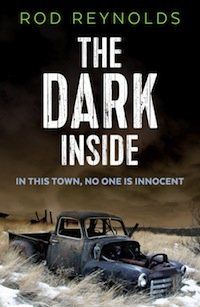The debut novel from Rod Reynolds arrives with a curious comparison: ‘for fans of True Detective’ has been added on the cover. You can understand the marketing motivation, but this book doesn’t really resemble the modern-era crime drama tinged with cosmic terror that was created by noir novelist Nic Pizzolatto. There is a serial killer lurking in the pages of The Dark Inside and Reynolds is adept at planting a sense of foreboding in his prose, though the post-war setting and a knotty plot involving secrets, brutal cops and double-crossing characters is perhaps more suggestive of hardboiled suspense.
Like Ray Celestin, debut author of The Axeman’s Jazz, Reynolds is a British author who’s confident about portraying the American South in a period crime novel that draws on a real-life case. But while Celestin employed various character viewpoints, Reynolds has stuck with a first-person perspective throughout The Dark Inside. Fortunately, wayward newspaperman Charlie Yates is an intriguing enough character to maintain your attention for the novel’s 400 pages. Exiled from his job in New York and feeling guilty over his failure to fight in the war, Yates is not your typical gung-ho hero – but he can sometimes be a bloody-minded reporter.
Reynolds has also found an unusual location for his sinister story set in 1946. Texarkana is on the border of Texas and Arkansas, and it is effectively one town straddling both states – Reynolds describes The Lone Star Diner located opposite Arkansas Liquor. It’s a geographical quirk that plays little role in the plot, though Reynolds does draw parallels between the border town and the dual nature of his characters: troubled, secretive and sometimes untrustworthy.
Having returned to work from an inglorious injury unrelated to the war, Yates was sent away from The New York Examiner like a bad smell and has been tasked with a non-story (at least for New Yorkers) about a killer in Texarkana. Young couples have been attacked while parked up in lovers’ lanes. Yates makes contact with the town’s newspaper, a sister title to his New York employer, though his Texan colleagues are not entirely welcoming – one reporter is soon waving a gun in the face of this outsider.
When another attack occurs, Yates becomes focused on catching the killer. In part it’s guilt at his wartime cowardice and a distraction from his failed marriage, but he’s also fallen for Lizzie, the older sister of the girl who somehow survived the first attack. However, he meets fierce opposition from the local police, who appear to control the town and maybe even the newspaper’s journalists. Sheriff Bailey is a domineering Texan who sanctions violence against troublemakers and, in one memorable scene, confronts Yates over his failure to serve his country. Bailey is one of those war heroes who perhaps enjoyed the fight a little too much, even if he’s not quite as psychotic as the sheriff in Jim Thompson’s Pop 1280.
Yates becomes fixated on a connection with the nearby Red River army depot, although there’s a suggestion that his antipathy towards returning GIs may be a result of his own inability to fight. He also has his own ‘dark inside’: the bad temper and boozing that led to a marriage breakdown, as well as a tendency to chase headlines without considering the emotional suffering of those caught up in the story.
The Dark Inside remains a genuine mystery as we follow the first-person perspective of Yates in this serial-killer case. Just as it begins to get a bit too baffling, the plot kicks in during the second half, which I raced through in a single sitting. While those True Detective comparisons don’t quite stand up, there’s no doubt that Reynolds creates a powerful feeling of fear in a Southern town paralysed by the threat of a phantom killer, while the violent tendencies of the corrupt cops are almost as worrying.
There are also some great lines that recall masters like Raymond Chandler: “…when you can’t see what the angle is, it means you’re the mark,” is a sentence that evokes the classics of hardboiled crime. The Dark Inside is an impressive and evocative first novel that shows all the signs of being a captivating period crime series.
Faber & Faber
Print/Kindle/iBook
£4.20
CFL Rating: 4 Stars










